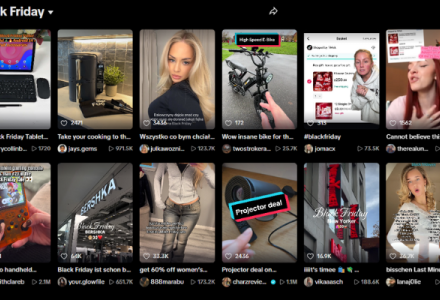How Brands Can Connect with Gen Z: The Future Shoppers
Generation Z has grown to become one of the most influential age groups in recent years and is now the largest generation, making up 32% of the global population. Defined as anyone born between 1997 and 2015, they have an estimated spending power of $150 billion in the US alone, making them an increasingly important target market for companies.
Champions of individuality, inclusivity, authenticity, and ethical living, it’s no secret that this generation think, act and buy differently from their predecessors. On average, these youngsters spend 5x less time watching broadcast TV than Boomers and 62% of Gen Z shoppers use non-traditional media like Instagram and TikTok to discover new brands and products. What’s more, they buy on impulse and will return a whopping 75%+ of the items they buy online. In order to successfully reach and engage these future shoppers, it is imperative for brands to understand how Gen Z discover, research and ultimately buy brands online.
Below, we look at some of the key findings from our joint report Add to Cart and discuss the implications of our findings for brands.
Price Over Ethics
Gen Z are often characterised as the ‘woke’ generation and have built themselves a reputation for leading the conversation around sustainability and ethical living. However, from our own proprietary research in our report Add to Cart, we found that price is in fact the biggest barrier to entry for Gen Z shoppers. Namely, 42% of our respondents said that price was the most important factor when buying online.
People within this age range are typically students and newly grads who are still living with their parents. Most are on low paid jobs or living off student loans which makes it difficult for them to splurge on sustainable products which are often pricey purchases. Whilst these factors remain important considerations for Gen Z, they are treated as value-added ‘nice to haves’ that help to distinguish brands from competitors at the active evaluation stage of the shopper journey. Without an affordable price tag, most brands will not make it past the initial consideration phase.
An online marketplace like Amazon is a great option for brands as it pushes to ensure that pricing is transparent, making it simple for Gen Z shoppers to compare against competitors. Additionally, brands must do their research and ensure that they are able to offer products at a competitive price after factoring in the various fees like FBA storage and commission before launching on Amazon. Pricing reviews and commercial strategies are a key part of this process and will enable businesses to understand how best they can remain profitable as well as competitive.
Borrowing Trust
When money is sparse, every purchase is a careful consideration. This is why Gen Z shoppers cannot risk buying from a less reputable platform that may not deliver their item, or a product they are not 100% sure about. Our research shows that trust plays a key role in purchase decision making and shoppers no longer blindly follow polished ads from faceless corporations: building trust through strong brand reputation and partnerships with reputable platforms are now prerequisites for engaging with young people.
However, building trust takes time. Unlike those before them, this audience no longer listens to what brands have to say. Instead, many future shoppers are initiating their own research with the help of influencers, Amazon, reviews and comparison sites. Social proof and the voices of third parties help them gauge the value of a product or the reliability of a website. But it's not just reviews: the quality of service also helps to build confidence. For example, Amazon’s reputable next day delivery with the Amazon Prime badge is now synonymous with fast and free delivery. When combined with an excellent returns policy, our research shows that this makes Amazon the preferred platform to buy from for 42% of Gen Z (with only 24% saying they prefer to buy from the brands own website).
Smaller brands and startup businesses can use respected third party platforms like Amazon to ‘borrow trust’ and create instant credibility. With a fully optimised presence, strong reviews and a varied product selection, association with these well-established marketplaces is a shortcut to verifying and validating your brand online. However, this does not mean that brand websites are obsolete; they are an important place for shoppers to research and experience your brand. Amazon is limited in terms of what you can do with your listings or A+ content, therefore, a brand website should be a platform where consumers can fully experience your brand. Look to build an emotional connection with consumers in this space.
Discovery and research
Discovery is a critical part of the shopper journey. When you consider that only 24% of our Gen Z respondents said they discovered a new brand from TV, compared to 43% from live streaming, it is clear that the way they find new brands is evolving.
What’s more, 44% of our Gen Z respondents said that they prefer to discover brands on Amazon and it is fast replacing Google to become consumers’ first port of call when finding new products online. Despite this, brand development on Amazon is often overlooked by companies who view the platform as merely a functional portal for sales. This is a dangerously outdated point of view. Prior to purchase, consumers are using Amazon to discover new brands, compare product specifications, prices and reviews, all without leaving the website. This reflects Amazon’s evolution beyond a purely transactional platform.
Brands can maximize their discoverability by utilising the new and evolving touchpoints on Amazon like brand stores, A+ content and video ads. These allow you to tell a brand story, stand out on the platform and magnify values with visually rich media. Brands also need to focus on aligning the content on Amazon with above the line marketing activity to create a seamless shopper journey across all platforms for optimum engagement. Amazon is so competitive that taking advantage of all of these opportunities to really connect with Gen Z on both a personal and cultural level is key to standing out from the crowd.
Understanding online marketplaces can be challenging and confusing. At Tambo we have helped a number of different brands like Caffe Nero, Patisserie Valerie, Willy’s Apple Cider, Soho Juice, Molton Brown and Next get started and succeed on platforms like Amazon and Zalando. If you would like to start your marketplace journey, get in touch with us and we’d love to work with you.
You can download our full report, Add to Cart, where we deep-dive into six key takeaways for brands, here.



